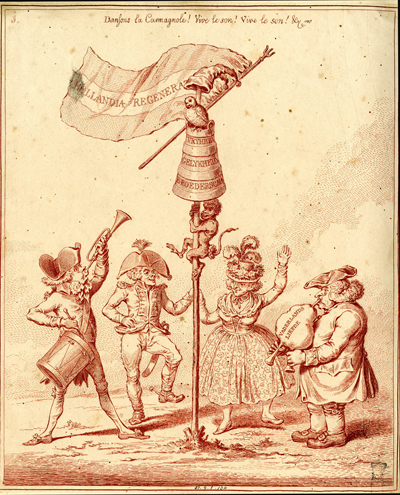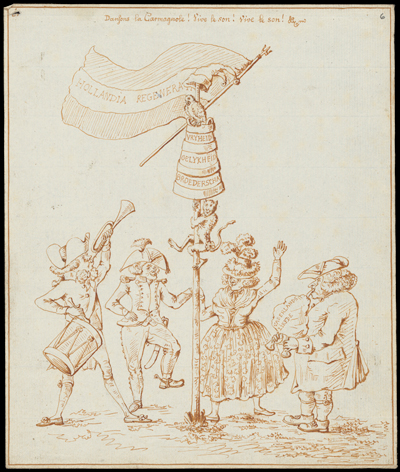Dansons la Camagnole! Vive le son! Vive le son!. . .
This is the frontispiece and first plate of a twenty plate series, Hollandia Regenerata, etched by Gillray based on drawings by the Swiss soldier, painter, and caricaturist, David Hess. For more about David Hess, and the political and artistic context of the series satirizing the newly-created and French-supported Batavian Republic, see my Introduction.

Dansons
la Camagnole! Vive le son! Vive le son!. . .
[1796]
© Trustees of the British Museum
The print shows a Dutch man and his wife, accompanied by musicians playing the trumpet, drums and bagpipe, celebrating the new revolutionary Batavian Republic established in January of 1795. They dance around a so called "liberty tree," one of the symbols of the supposed growth and proliferation of French revolutionary principles. Near the top of the "tree" is a milk churn inscribed with some of of those principles: Liberty, Equality, and Fraternity. And on the very top, the Phrygian cap of liberty (bonnet rouge) and the French tricolour flag. The couple is dancing the Camagnole. We know that because the inscription above the image: "Dansons la Camagnole! Vive le son! Vive le son!" is in fact the refrain of the song, La Camagnole which was extremely popular among revolutionary supporters as both a dance and a song.
As with all the plates in the series, the corresponding page to the image contains one or more appropriately ironic Biblical quotations in Dutch and English and a satiric "Explanation" in French. The Biblical quotations are as follows:
The Acts, vii. 41. "And they made a calf in those days, and offered sacrifice unto the idol, and rejoiced in the works of their own hands."
Job, xviii. 16. "His roots shall be dried up beneath, and above shall his branch be cut off."
Here is the French text of the "Explanation."
L'arbre de la liberté s'eleve dans toute sa splendeur! le drappeau tricolore flotte dans les airs! liberté, egalité, fraternité, sont à l'ordre du jour. Un Batave avec sa douce moitié danse la carmagnole au son d'une trompette, d'un tambour, et d'une cornemuse, la joye est generale. Même le singe qui est de la partie, grimpe avec enthousiasme le long du saint arbre, audessus duquel le peroquet Batave tache d'imiter les accens patriotiques de ses frêres Français.
And here is my free English translation.
The Tree of Liberty arises in all its splendor. The tri-coloured flag floats in the air. Liberty, Equality, and Fraternity are the watchwords of the day. A Batavian, with his sweet better half, dances the Carmagnole to the sound of a trumpet, a drum, and a bagpipe. Joy is widespread. Even the monkey, who is part of the group, enthusiastically climbs the length of the sacred tree, while just above the Parrot tries to mimic the patriotic accents of his French brothers.
The Biblical quotation from Acts and Job suggest that the Dutch dancing around the tree are as deluded as the Israelites worshipping the golden calf. Indeed we notice that the Phrygian cap upon the top of the churn features the bells of a fool's cap. The foolishness of the enterprise is further reinforced by the presence of the monkey climbing the pole (but ultimately blocked by the French inscribed churn) and by the parrot inanely mimicking the French song. Far from representing the natural growth and spread of liberty, then, this tree is of foreign implantation, and, as suggested by the quotation from the Book of Job, is doomed to extinction.
The musicians alongside the dancers have one rather odd feature in common: both seem to be doing two things not normally seen together. In one case the musician plays a drum and a horn at the same time. In the other, a bagpiper seems to be playing a bag with two "chanters" instead of one using both hands. The bagpipe is labeled Fatherland Love or Patriotism, which may then hint at divided loyalties among the figures in spite of the appearance of harmony.

Dansons
la Camagnole! Vive le son! Vive le son!. . .
[1796?]
© Zentralbibliothek Zürich
As in most of the plates of Hollandia Regenerata, Gillray follows the Hess's drawing very closely. The disposition of the figures and the details and meaning of the print all derive from Hess, but Gillray has sharpened every line and with a wonderful use of shading given a depth and solidity to the ground and the figures that is missing in the original Hess drawing. And in a small departure from Hess, Gillray has also made Hess's monkey look more like a monkey and less like a cat.
Sources and Reading
- Commentary from the British Museum on Dansons la Camagnole! Vive le son! Vive le son!. . ..
- Draper Hill, Mr. Gillray The Caricaturist, 1965, p. 73 & note.
- "Batavian Republic," Wikipedia
- "David Hess (painter)," Wikipedia
- "David Hess," SIKART Dictionary
- David Hess, Hollandia Regenerata (1797), Nawoord by Joost Rosendahl, Uitgeverij Vantilt, 2007
- "Carmagnole," Wikipedia
- "Liberty pole," Wikipedia
- "Liberty Tree," Wikipedia
Comments & Corrections
NOTE: Comments and/or corrections are always appreciated. To make that easier, I have included a form below that you can use. I promise never to share any of the info provided without your express permission.